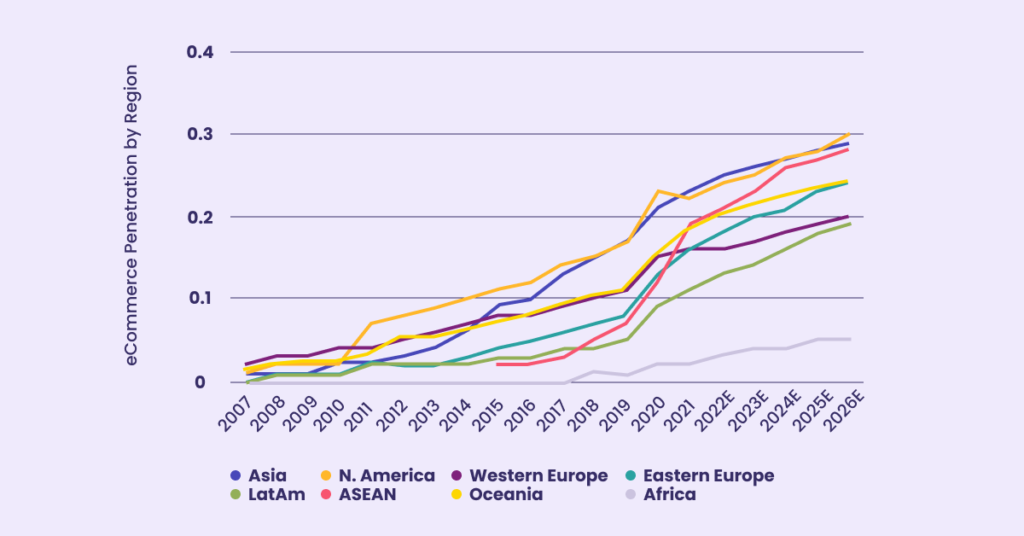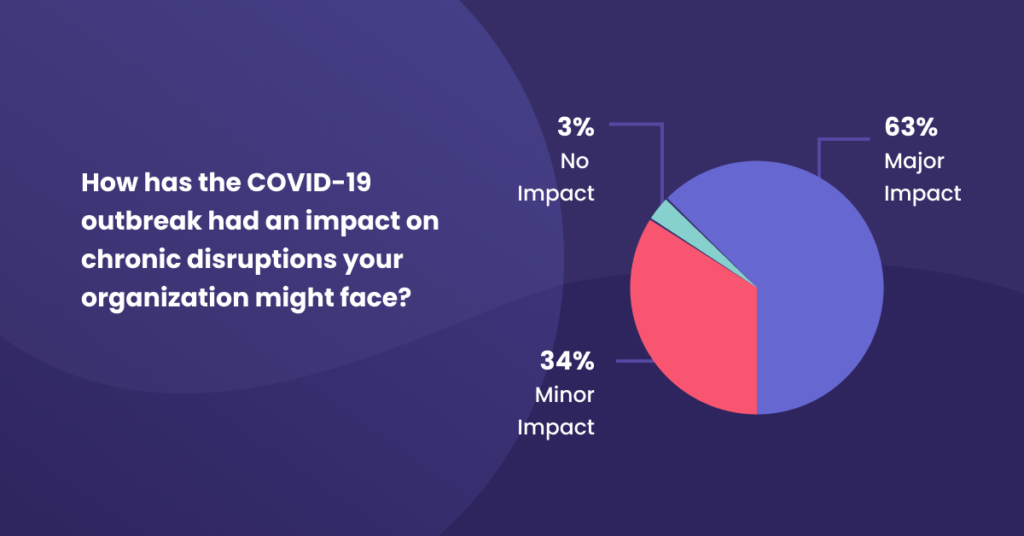In this article, we look at the customers flocking to e-commerce. Online shopping is nothing new but the attention to customer experience on these digital platforms has reached an all time high.
As the biggest names in the retail industry steer their investments toward e-commerce, here are some innovative ideas to improve your online customer support.
- The rise of e-commerce
- What do online customers want?
- Common obstacles: Why online customer service fails
- 3 Innovative solutions: Customer care in the Digital Age
- 3 Strategic improvements: Empowerment and Performance Management
The rise of e-commerce
E-commerce is a catch-all descriptor that refers to the purchase and sale of goods and services online. And it would be a disservice to underestimate the enormous impact Electronic Commerce (e-commerce) has made on our way of life.
Shopping online is an option open to all markets, including business-to-business (B2B), business-to-consumer (B2C), consumer-to-consumer (C2C), and consumer-to-business (C2B). The website boom not only brought us an overwhelming amount of information but an incredibly accessible bridge to diverse and widespread markets.
After the incredible surge in online shopping due to the global pandemic, Morgan Stanley estimated that this $3.3 trillion industry will continue to grow, reaching $5.4 trillion globally by 2026.
As Internet access becomes a greater priority for governments worldwide, new market opportunities and competitors emerge like mushrooms after rain in the already flooded e-commerce space.

You can buy almost anything online today.
You want a mug with your childhood home on it? Open Google and find a website.
Trying to sell your used furniture? Hop on Facebook Marketplace, or any of the other integrated e-commerce platforms — and it will sell in an hour!
Standing out in this competitive space requires a resilient online strategy.
So, where do you start?
You guessed it right.
The customers.
What do online customers want?
Customers at physical and online stores actually want the same thing from their customer service:
A simple, personalized, and delightful shopping experience.
The difference is in the details. Let’s take a moment to look at how the ideal customer journey changes in the digital space.

Online customer experience
There are three pillars that define the customer journey.
The first one to note is Customer experience. Customer experience refers to the relationship customers build with your brand from start to finish. Customer experience starts from the moment someone becomes aware of your products or services and continues after the purchase. It’s important to emphasize here that the customer experience is not entirely in your control but there are ways to influence a customer’s long-term relationship with your e-commerce business for the better.
The online customer expects their favorite companies to have an online presence. In fact, McKinsey reported that 75% of US customers will move strategically across online platforms — exploring social media, company sites, comparison blogs, and more — to gather what they perceive as a complete understanding of how your products are positioned in the market and whether they match their personal needs.
Hot tip for omnichannel customer experience:
80% of succeeding e-commerce companies are carefully positioning their products to match the kind of information customers expect to see on the given platform.
Online customer service
Customer service is the backbone of any business.
Mastering the art of online customer service is most definitely in your best interest when diving into e-commerce.
The principles of online service, incidentally, are perfectly aligned with the functional use of online communication. Customer service is an element of the customer experience that occurs in short but repetitive bursts. The best online customer support, then, capitalizes on existing expectations for spaces like social media, text messages, or live chat to check in with their customers.
Online customer service strategies vary depending upon industry. Generally speaking, messages are exchanged through a live chat, phone call, e-mail, or via social networks.
Hot tip for building the best online customer support:
Whatsapp — the world’s third most used social platform, according to Hootsuite — is quickly becoming an incredibly significant channel for simple and quick communications.
Online customer success
The third pillar of the customer journey is achieving and maintaining customer success.
Customer success is the communications that a company uses to guarantee — or make corrections to ensure — a successful purchase, delivery and optimal functionality of the product sold.
Customer success teams typically work with a proactive strategy to online customer care: they don’t wait until a problem arises. This team’s goal is to catch a problem and reach out to customers before they notice it. Then, even in the case of a successful delivery, customer success teams take that opportunity to check in with the customer to ensure they understand their product.
Hot tip for improving online customer success:
Keep an eye on repeat issues. Listening to customers and documenting their grievances can provide insight into larger problems with your product or services. The entire business will be grateful that their support heroes are saving the day once again!
Common obstacles: Why online customer service fails
Believe it or not.
Whether you have a support team of 15 or 50, the challenges your business can face on an e-commerce platform are the same across the board.
Below are the common obstacles that online customers face:
- Unclear checkout process
- Customer service availability
- Shipping and delivery issues
- Website displays on ‘out of stock’ items
- Slow service response times
- Ineffective mobile app
- Unpredictable service disruptions
- The return process is confusing
It’s important to emphasize that these are indeed common issues that ecommerce companies have across the board.
The Association for Supply Chain Management reported in 2022, 63% of companies experienced a major impact from the supply chain disruptions resulting from the COVID-19 pandemic. Underestimating the likelihood that these challenges will affect your business is a huge mistake. One that could drastically affect your reputation as a brand and cost you customers.

3 Innovative solutions: Smart ways to provide online customer care
Diversify your service channels
The challenge: Slow service response time
Strategic innovation: A united omnichannel approach
Diversifying your service channels is key to creating a simple, personalized and delightful customer experience. The range of channels through which customers can communicate with your customer service representatives feel endless — Whatsapp, SMS, Direct Messages on social media, pop-up chatbots — you name it.
When choosing support channels, consider the values, needs, and expectations your target audience has. Improving your online customer service means creating opportunities to communicate in the ways that feel most comfortable.
According to Statista, for example, luxury brands have been seriously pursuing Whatsapp as a direct contact channel. Whatsapp is a very popular channel for e-commerce teams as it is fast, easy to manage, and equipt for multitasking agents. Video shopping on Zoom or Facetime is also making its mark, ranking 3rd in worldwide offerings.

PWC reports that the luxury retail industry typically lags behind the mass markets in terms of quality online customer service. For our Ultimate Guide to E-commerce Operational Efficiency, Kaizo spoke to Dorien De Vreede, Head of Support at Bloomon, who gave this insider advice:
“Guiding your customers towards your preferred channel is all about visibility. If you want people to contact you via Whatsapp, then work with your UX team to make sure it’s always the first option they see when they get in touch.”
Video chat is also an incredibly effective way of providing a high quality of service online. Especially for B2B or B2C IT companies, having an opportunity to engage with your products can make or break an online sale.
In a recent podcast, Kaizo spoke with Darren Chait – Co-Founder and COO of Hugo, who raves about this strategy. With the video calling service, Hugo agents can solve questions quickly, reassure the customer, and build relationships with their users.
Having video calling solutions you are able to make in-store, offline experiences accessible to customers using a smartphone, tablet, or laptop in a convenient location. This improves customer satisfaction and generates sales profits.
Proactive customer care
The challenge: Unpredictable service disruptions
Strategic innovation: Leveraging an omnichannel strategy to alert your customers across platforms
In a reactive sense, customers want fast and uncomplicated solutions to their problems. Approaching online customer service reactively is an industry-standard. Ensuring these processes stay efficient and reliable is an ongoing activity for any customer service professions.
However, what we explained above is an example of proactive customer service, and it is a much better approach to online customer support.
As we will explore later, working in e-commerce opens up businesses and customers to unpredictable disruptions. What recent conditions in the supply chain have taught us is that communication is key to mitigating business risk in times of crisis.
For example, Trainline – a European e-commerce platform – recently launched delay notifications to alert customers about delays in travel.

The bottom line is, transparency and communication are your best crisis control.
To ensure you maintain a level of trust with your customers, keep an eye on major events that may affect your service delivery — be it a support team shortage, a protest blocking the supply chain, or back-end glitch on your website that could create issues at check-out. As you notice these disruptions, make sure that your entire support team knows what is happening, why, and what process it will affect.
Customers feel safer trusting a company when they are not afraid to address issues. In fact, 78% of customers, according to Salesforce, would forgive a company for its mistake after receiving excellent service. This is key with the unpredictabilities associated with our online work today.
Self-service solutions
A challenge that businesses can face on the backend of ecommerce is navigating the rocky waters of 24/7 customer service. How can we expect that agents will be able to answer requests when they come from your loyal customer, Isaac, whose software is glitching at 1 am the night before a deadline?
One way to improve online customer support is to help your customers help themselves.
Creating valuable self-service tools for your e-commerce platform is the perfect solution for the modern online shopper. According to Zendesk’s 2022 CX Trends Report, 89% of customers prefer companies that provide them the choice to find answers without speaking to a support representative.
FAQ pages and sponsored community forums provide an organic and resource-rich space for customers to empower their self-service customer care.
According to McKinsey, there has been a shift in shopping mindsets globally. With up to a 45% rate of change, McKinsey reports that more online shoppers will spend time researching product choices before purchase.
So how do you improve customer service?
Online shoppers are in the front seat of their customer journey and they like it that way. Why not give them the information they’re looking for?
3 Strategic improvements: Empowerment and Performance Management
Forecasting staffing needs
As we’ve already learned, e-commerce opens a new can of issues for online shoppers to face and your customer service agents to solve. It’s no wonder so many companies decide to ditch their manual dashboards for smarter service management solutions.
Many of our users note that they made the switch to Kaizo because they were sick of wasting time with complicated spreadsheets and unrepresentative time logs. For a transitioning business, having automated time-tracking features built into its operating system can fast-track scheduling for the future.
Kaizo, for example, provides managers with an automation feature that measures the time agents spend in Zendesk. When support team managers are looking to forecast their staffing needs, they can look to the Heatmap which easily visualizes trends in online Helpdesk interaction. With this, managers have access to actionable information that takes the guesswork out of staffing needs.

Divide and conquer backlogged requests
Imagine your service team wakes up to a full inbox, plus 30 other service requests across all channels.
Luckily you, the Team Lead, scheduled enough agents to handle the overflow of requests. But now you need to effectively manage your agents’ workflow.
How do you create a strategic and scalable Standard Operating Procedure (SOP) that will preserve your reputation of having stellar online customer service?
Keep in mind that customer service is also a financial investment. If it doesn’t make sense for your bottom line to have 24/7 live support, then finding low-cost and easily manageable alternatives should become a priority.
A common management strategy for teams facing a drastic influx of tickets is to
divide and conquer. Kaizo, for example, gives managers the opportunity to dedicate shifts where they de-prioritize real-time channels like live chat or social media DMs.
This way the customer support team can focus on how to best help customers and save time that would have otherwise been spent on clearing backlog tickets. A job for the next shift of agents to tackle without the stress of answering a backlog of real-time tickets.
Skill up your support reps
How to interact with customers is an industry-specific skill set that must be included in support agent training. Teaching agents appropriate online etiquette helps make the best impression upon first contact. By providing regular training, you can ensure that your agents are always in the know about the latest service policies and customer engagement techniques.
Ensure that your business’s training curriculum includes information about the importance of empathy, customer buying habits, and cultural values that your target audience is aligned with. Integrating these lessons is an advantage for a lot of online companies.
The best way to show customers genuine empathy and cultivate a community around your product is to respond to their questions, solve their challenges, and provide calming and positive emotions. It takes empathy and understanding to differentiate yourself based on online interactions and it will be the best tool to increase customer loyalty.

Empowering support teams with continuous and evidence-based training is an effective way to improve online customer satisfaction and support team motivation. Kaizo helps businesses in building a coaching culture for customer service representatives. When dedicating time and resources to regular training sessions, managers need to ensure those skills are put into practice.
The integrated Scorecard in Kaizo is an entirely customizable feature that provides an itemized overview of your team’s performance. The automated real-time analysis helps Team Leads compare entire teams or individual agents based on metrics, channels, and time periods/zones.
Comparing and evaluating performance can keep managers in touch with what skills need to be leveled up and which training prioritized. Additionally, upper-level directors will have access to a company overview to review and validate the need for more investment in professional development for their support agents.

Final advice
Remember — a lot has changed about the marketplace in our short time on earth, but humans? We’ve stayed the same.
We want to be heard, to choose our way in life, and we want a simple life.
AI, automation, and data can be a vehicle for that. Don’t be afraid to take the risk!
Innovate to improve your online customer service today!



